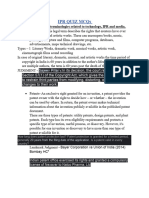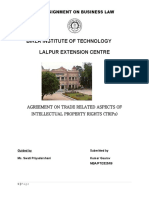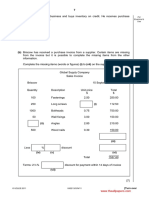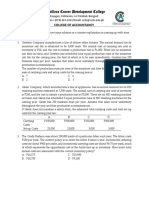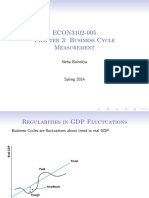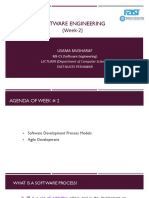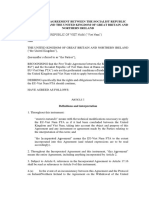Intellectual Property Rights
Intellectual Property Rights
Uploaded by
bhagatsahil608Copyright:
Available Formats
Intellectual Property Rights
Intellectual Property Rights
Uploaded by
bhagatsahil608Copyright
Available Formats
Share this document
Did you find this document useful?
Is this content inappropriate?
Copyright:
Available Formats
Intellectual Property Rights
Intellectual Property Rights
Uploaded by
bhagatsahil608Copyright:
Available Formats
SR COLLEGE OF COMPETITIONS
10 A/C, Gandhi Nagar, Jammu. Ph.: 2456098, 9419146810
INTELLECTUAL PROPERTY RIGHTS
"Intellectual property" refers to creations of the mind. These creations can take many
different forms, such as artistic expressions, signs, symbols and names used in
commerce, designs and inventions.
Governments grant creators the right to prevent others from using their inventions,
designs or other creations — and to use that right to negotiate payment in return for
others using them. These are “intellectual property rights”.
They take a number of forms. For example, books, paintings and films come under
copyright; eligible inventions can be patented; brand names and product logos can be
registered as trademarks; and so on. Governments grant creators these rights as an
incentive to produce and spread ideas that will benefit society as a whole.
The WTO’s Agreement on Trade-Related Aspects of Intellectual Property Rights
(TRIPS), negotiated during the 1986-94 Uruguay Round, introduced intellectual
property rules into the multilateral trading system for the first time.
TRIPS Agreement looks at different kinds of intellectual property rights and how to
protect them. The purpose is to ensure that minimum standards of protection exist in all
WTO members.
Some amount of intellectual protection existed even before the arrival of WTO and
TRIPS . The World Intellectual Property Organization (WIPO) had already existed
before the WTO was created .
World Intellectual Property Organization :- World Intellectual Property
Organization (WIPO) is the United Nations agency which serves the world’s innovators
and creators . It ensures that their ideas of innovators get the benefit of their
commercialization in the market. Besides these ideas improve quality of lives of the
people . It was established in 1967 and has 193 members .Its headquarters is at Geneva
(switzerland) .
SOME FORM OF PROTECTION THAT EXISTED EVEN BEFORE WIPO :-
PARIS CONVENTION FOR THE PROTECTION OF INDUSTRIAL PROPERTY 1883 :-
The Paris Convention, adopted in 1883, applies to industrial property in the widest
sense, including patents, trademarks, industrial designs, utility models, service marks,
trade names, geographical indications and the repression of unfair competition. This
international agreement was the first major step taken to help creators ensure that their
intellectual works were protected in other countries.
The Paris Convention, concluded in 1883, was revised at Brussels in 1900, at
Washington in 1911, at The Hague in 1925, at London in 1934, at Lisbon in 1958 and at
Stockholm in 1967, and was amended in 1979.
BERNE CONVENTION FOR THE PROTECTION OF LITERARY AND ARTISTIC WORKS
The Berne Convention, adopted in 1886, deals with the protection of works and the
rights of their authors. It provides creators such as authors, musicians, poets, painters
etc. with the means to control how their works are used, by whom, and on what terms.
CATEGORIES OF INTELLECTUAL PROPERTY
Intellectual Property rights commonly encompass Patent, Trademarks, Industrial
Design, Copyright, Geographical Indication of Goods, Integrated Circuit and Protection
of Undisclosed Information such as Trade Secrets.
J&K’s IAS/JKAS Academy By (DR.RAJ SHEKHAR) Page 1
SR COLLEGE OF COMPETITIONS
10 A/C, Gandhi Nagar, Jammu. Ph.: 2456098, 9419146810
Patent refers to inventions, each embodying a new idea capable of being made or used
by industry and involving a non-obvious inventive step. .
Patents: The Patents Act, 1970 as amended in 1999, 2002 and 2005.
Copyright refers Literary and artistic works, films, videos, records, broadcasts and
typographical arrangements, including computer software.
Copyright (or author’s right) is a legal term used to describe the rights that creators
have over their literary and artistic works. Works covered by copyright range from
books, music, paintings, sculpture, and films, to computer programs, databases,
advertisements, maps, and technical drawings.
Copyright: The Copyright Act amended in 1983, 1984 and 1992, 1994, 1999, 2012 and
the Copyright Rules, 1958. Government of India has notified Copyright (Amendment)
Rules, 2021 .
Registered Design refers to designs and design drawings, mainly right of aesthetic
objects, engineering components, architectural drawings, etc.
Design: The Design Act 2000
Trade Marks refers to product brand names, company logos, etc
A trademark in general refers to a mark that distinguishes one enterprise from the
other. Section 2(zb) of the Trademark Act [1999], defines a trademark as “a mark
capable of being represented graphically and which is capable of distinguishing the
goods or services of one person from those of others”.
Trade Mark: The Trade Marks Act, 1999
The Trade Marks Registry was established in India in 1940 and presently it
administers the Trade Marks Act, 1999 and the rules there under. It acts as a resource
and information centre and is a facilitator in matters relating to trade marks in the
country.
The objective of the Trade Marks Act, 1999 is to register trade marks applied for in the
country and to provide for better protection of trade mark for goods and services and
also to prevent fraudulent use of the mark. The main function of the Registry is to
register trade marks which qualifies for registration under the Act and Rules.
Logo of some important Indian companies .
J&K’s IAS/JKAS Academy By (DR.RAJ SHEKHAR) Page 2
SR COLLEGE OF COMPETITIONS
10 A/C, Gandhi Nagar, Jammu. Ph.: 2456098, 9419146810
Logos of some important foreign Multinational Corporations (MNC’s)
Layout design of integrated circuits refers to a layout of transistors and other
circuitry elements, lead wires connecting such elements, expressed in any manner in
semiconductor integrated circuits. In India, Semiconductor Integrated Circuits
Layout-Design Registry (SICLDR) supervises examination and registration of Layout-
Designs of integrated circuits.
Layout Design of Integrated Circuits: The Semiconductor Integrated Circuit Layout
Design Act 2000.
The Registry functions as per the guidelines laid down in the Semiconductor Integrated
Circuits Layout Design (SICLD) Act 2000 and the Semiconductor Integrated Circuits
Layout-Design (SICLD) Rules 2001.
Design of IC on a Processor.
What are other types of Intellectual Property Rights?
Besides the above major types of Intellectual property rights, Trade secrets and
Protection of Plant Varieties and Farmers‟ Rights (PPVFR) Act are also forms of IP
protection. The details of each of these rights are provided below.
Plant Varieties:---- The Protection of New Plant Variety and Farmers Rights Act
2001.
TRADE SECRET :-
A trade secret refers to confidential information that is protected and utilized by a
company to have competitive advantage. A trade secret broadly comprises of
manufacturing secrets, composition secrets, commercial secrets etc.
J&K’s IAS/JKAS Academy By (DR.RAJ SHEKHAR) Page 3
SR COLLEGE OF COMPETITIONS
10 A/C, Gandhi Nagar, Jammu. Ph.: 2456098, 9419146810
Protection of Undisclosed Information: No exclusive legislation exists but the matter
would be generally covered under the Contract Act, 1872, amended 1996
DIFFERENCE BETWEEN TRADE SECRET AND PATENT
A patent is a techno-legal document, which has a prescribed format and is registered at
the Indian Patent office and similarly in concerned authorities in other countries
whereas a trade secret is not registered.
The patented information is therefore disclosed and recorded in a public domain
source while the trade secret are undisclosed and remains as a secret with its
owners. There is therefore limited or no legal protection in case of leakage of such
confidential information.
The term of a patent of protection is fixed viz., 20 years from the time of filing,
whereas life of a trade secret is indefinite as long as the owner of such information is
able to keep confidential.
LEGISLATIONS COVERING DIFFERENT KINDS OF IPRS IN INDIA
Different types of IPRs are governed by separate legislations as given below:
Patents: The Patents Act, 1970 as amended in 1999, 2002 and 2005.
Design: The Design Act 2000
Trade Mark: The Trade Marks Act, 1999
Copyright: The Copyright Act, 1957 as amended in 1983, 1984 and 1992, 1994, 1999,
2012 and the Copyright Rules, 1958.
Layout Design of Integrated Circuits: The Semiconductor Integrated Circuit Layout
Design Act 2000.
Protection of Undisclosed Information: No exclusive legislation exists but the matter
would be generally covered under the Contract Act, 1872, amended 1996
Geographical Indications: The Geographical Indication of Goods (Registration and
Protection) Act 1999.
Plant Varieties: The Protection of New Plant Variety and Farmers Rights Act 2001.
The intellectual property laws come under Department of Industrial policy &
promotion(DIPP) comes under Ministry of commerce except for plant variety
which is under Ministry of agriculture. The Department of Industrial Policy and
Promotion (DIPP) has been renamed as the Department for Promotion of
Industry and Internal Trade with a mandate to deal with matters related to start-ups,
facilitating ease of doing business .
PATENT
A Patent is a statutory right for an invention granted for a limited period of time
to the patentee by the Government. In exchange , the patentee provides of full
disclosure of his invention . Patent excludes others, from making, using, selling,
importing the patented product or process for producing that product for those
purposes without the consent of patentee.
The term of every patent granted is 20 years from the date of filing of application.
However, for application filed under national phase under Patent Cooperation Treaty
(PCT), the term of patent will be 20 years from the international filing date accorded
under PCT.
J&K’s IAS/JKAS Academy By (DR.RAJ SHEKHAR) Page 4
SR COLLEGE OF COMPETITIONS
10 A/C, Gandhi Nagar, Jammu. Ph.: 2456098, 9419146810
The patent system in India is governed by the Patents Act, 1970 as amended by the
Patents (Amendment) Act, 2005 and the Patents Rules, 2003. The Patent Rules are
regularly amended in consonance with the changing environment recent being in 2016
and patent (amendment)rule 2024.
Does Indian Patent give protection worldwide
Patent protection is a territorial right and therefore it is effective only within the
territory of India. There is no concept of global patent.
In general, the exclusive rights are only applicable in the country or region in which a
patent has been filed and granted, in accordance with the law of that country or region.
However, filing an application in India enables the applicant to file a corresponding
application for same invention in convention countries or under PCT, within or before
expiry of twelve months from the filing date in India. Patents should be obtained in each
country where the applicant requires protection of his invention.
An invention is patentable subject matter if it meets the following criteria –
i) It should be novel.
ii) It should have inventive step or it must be non-obvious
iii) It should be capable of Industrial application.
iv) It should not attract the provisions of section 3 and 4 of the Patents Act 1970.
What is the Patent Cooperation Treaty (PCT)?
The PCT is an international treaty with more than 150 Contracting States which are
bound with certain formal requirements set out in the Treaty and Regulations. The PCT
makes it possible to seek patent protection for an invention simultaneously in a large
number of countries by filing a single international patent application instead of filing
several separate national or regional patent applications . However, granting of patents
remains under the control of the national or regional patent offices after the
corresponding national phase application has been filed and the national phase
application is assessed as per patent law of that jurisdiction.
As per Indian Patent Act 1970 as amended and the Patents Rules 2003 as amended by
(amendment) rules 2016, any PCT international application may be filed designating
India and it shall deemed to be an application if the corresponding national phase
application has also been filed.
A patent is the granting of property right by sovereign authority to an invertor. Patent
is granted for a period of twenty yaers .
Patent process in India:
Product patent(40’S ) – Process patent (1970) – Product patent (2005)
A Product patent gives the company (Exclusively marketing right) EMR to their
product. They can give license to another company to manufacture and market in a
particular country and in return the company taking royalty.
Process Patent:It means that the company can manufacture the same product by an
alternate process. Therefore, the Indian pharma sector expanded rapidly after this
change. India is also called pharmacy of world .India is the largest producer of generic
drugs in the world . Major supply of HIV and TB medicines from India.
Patent is granted for limited line period of 20 years a patent is territorial right. The
Indian patent act was amended in 2005 and we went for Product patent.
Covidshield – Patent is with Astra Zeneca and Oxford University .It is being
manufactured bry Serum Institute of India under license at Pune
Covaxin – Patent is with Bharat bio tech and ICMR (Indian council of medical)
J&K’s IAS/JKAS Academy By (DR.RAJ SHEKHAR) Page 5
SR COLLEGE OF COMPETITIONS
10 A/C, Gandhi Nagar, Jammu. Ph.: 2456098, 9419146810
COMPULSARY LICENSING
Compulsory licensing was one of the provisions negotiated under TRIPS. There was
difference of opinion between the developed world and developing world particular is
pharma sector. The developing countries agreed for product patent and the developed
country gave concession to the developing country is the form of compulsory license.
Compulsary license allows the govt to give permission to someone else to produce the
patented product or process without the consent of patent owner. Under compulsory
licensing the generic copy is produced mainly for domestic market not for export.
The patent owners will till have the right over the patent including he right to be paid
for authorised copy of the product. The TRIPS agreement lists a number of condition for
issuing compulsory license .
Normally the person or company applying for a license has to try to negotiate a
voluntary license with the patent holder at a reasonably commercial term. If the
negotiation failed then only the compulsory license can be issued.
Section 84 of Indian patent act 1970 states that compulsory license can be issued to a
person or company 3 years after the grant of the patent.
Section 84 states the conditions under which compulsory license can be issued-
(a)The reasonable requirement of the public with respect to the patented invention has
not been satisfied.
(b) The patented invention is not available to public to a reasonably affordable price.
(c) The patented invention is not worked produced is the tertiary of India.
Department for Promotion of Industry and Internal Trade /Department of
industrial policy and promotion (DIPP) is the agency for issuing compulsory license.
DIPP can seek information from drug controller general of India.
India issued the 1st compulsory license to NATCO pharma for manufacturing the drug
Nexavar. It is used in treatment of liver and kidney cancer. It is patented drug of the
German form (BAYER).
The price of the drug supplied by BAYER is around 3lakh per month. NATCO pharma is
supplying the same drug at the rupees of 9000 per month. BAYER appealed against this
decision at Indian patent appellate board (IPAB) .IPAB rejected the appeal against the
granting of compulsory license it further ordered that royalty should be 6% of the drug
cost .
Compulsory license (CL) and Ever greening of patent is important from socio-economic
condition prevailing in the developing countries and under developed countries. The
purchasing power is very limited is these countries and therefore affordable drug
becomes important.
EVERGREENING OF PATENT/SECONDARY PATENT
The patent period is for 20 years . After this period the drug becomes generic. It can be
manufactured by any pharma company. The Pharma company’s make slight change in
the original drug molecules and apply for secondary patent .
It is a method of indirectly lengthening the patent period . Many countries allow
secondary patent such as USA. Japan, European Union (EU)
Indian patent act 1970 (Amended 2005) does not allow ever greening of patent . Section
3 of Indian patent act defines inventions that are not patentable. The following are not
invention under this act.
a) An invention which is frivolous or which claims anything obviously contrary to well
established natural laws;
J&K’s IAS/JKAS Academy By (DR.RAJ SHEKHAR) Page 6
SR COLLEGE OF COMPETITIONS
10 A/C, Gandhi Nagar, Jammu. Ph.: 2456098, 9419146810
b) an invention the primary or intended use or commercial exploitation of which could
be contrary to public order or morality or which causes serious prejudice to human,
animal or plant life or health or to the environment;
c) the mere discovery of a scientific principle or the formulation of an abstract theory or
discovery of any living thing or non-living substance occurring in nature;
d) the mere discovery of a new form of a known substance which does not result in the
enhancement of the known efficacy of that substance or the mere discovery of any new
property or new use for a known substance or of the mere use of a known process,
machine or apparatus unless such known process results in a new product or employs
at least one new reactant.
Explanation.—For the purposes of this clause, salts, esters, ethers, polymorphs,
metabolites, pure form, particle size, isomers, mixtures of isomers, complexes,
combinations and other derivatives of known substance shall be considered to be the
same substance, unless they differ significantly in properties with regard to efficacy;
Mere discovery of a scientific principle or formulation of an abstract theory.
SECTION 3(D)
The mere discovery of a new form of a known substance which does not result in the
enhancement of Known efficacy of that substance will not be considerd invention . The
discovery of a new use of the known substance will not be considered invention. The
use of known process on apparatus until a new product is evolved will not be
considered invention.
EXPLANATION OF3 (D)
For the purpose of clause 3(D) salts esters, ethers, pure form particle size isomers,
mixture of isomers shall be considered the same substance until they vary significantly
is terms of efficiency.
Indian patent office decline the evergreening of drug “ GLIVEC ”. It is a blood cancer
drug manufactured by NOVARITS.
NOVARITS appealed against it at Indian Patent Appelate Board . This case went to
Chennai (madras) high court where it lost the case. Finally the case went to supreme
court which also ruled against NOVARITS .It stated that the B- crystalline form of
Imatinib mesylate can not be considered a new discovery. It does not have improved
efficacy over the previous form.
J&K’s IAS/JKAS Academy By (DR.RAJ SHEKHAR) Page 7
SR COLLEGE OF COMPETITIONS
10 A/C, Gandhi Nagar, Jammu. Ph.: 2456098, 9419146810
Johnson and Johnson had the patent for the drug “Bedaquiline” which is a life saving
drug for tuberculosis . Johnson and Johnson had patent on the active ingredient of
bedaquiline in India. This expired in 2023, which mean that no generic company can
make the drug in India until then.
The Indian Patent Office has rejected American pharmaceutical corporation Johnson &
Johnson’s (J&J) application for a patent on the paediatric formulation of World Health
Organization (WHO)-recommended TB drug “Bedaquiline “.
This decision from the Indian Patent Office comes on the heels of J&J’s decision last year
to not press for a patent over Bedaquiline salt for adult patients. This decision was
preceded by two major developments.
A pre-grant opposition had been filed by TB survivors, Nandita Venkatesan and
Phumeza Tisile (a South African TB advocate), in the Indian Patent Office.
Many see this as “ever-greening,” a technical term that describes how pharmaceutical
companies add on extensions to their patent 20-year patent terms. It was not allowed in
India .
J&K’s IAS/JKAS Academy By (DR.RAJ SHEKHAR) Page 8
SR COLLEGE OF COMPETITIONS
10 A/C, Gandhi Nagar, Jammu. Ph.: 2456098, 9419146810
TRADITIONAL KNOWLEDGE DIGITAL LIBRARY ( TKDL)
It is a collaborated project between Council for of scientific and industrial research
(CSIR) Ministry of science & technology and Ministry of Ayush . TKDL data base has
been created to prevent misappropriation of traditional knowledge at the international
patent office.
Example: Controversy on the patent on Turmeric & Neem granted in USA .
It is primarily aim that preventing the case of biodiversity theft and misappropriation of
traditional knowledge at the international patent office .
Traditional knowledge exist is local language such as Hindi, Tamil, Urdu, Oriya , Urdu
,telegu , kannada, marathi , hindi , konkani
These are translated into 5 international language:- English, French, German, Spanish &
Japanese in patent application form .Thus TKDL breaks the language barrier and format
barrier of the local traditional knowledge . It makes the knowledge available to the
patent examiner in their own language and is a format which is easy to understand .
For creation of TKDL data base, a classification took known as ‘Traditional knowledge
resource classification’ has been evolved. It enable proper entry of local medicine and
other information.
Govt. of India has given access to international patent office of TKDL data base. It has
successfully reduced the case bio piracy many other countries are trying to replicate
TKDL model to prevent Biopiracy and safe guard their traditional knowledge.
“The Protection of Plant Varieties and Farmers’ Rights (PPV&FR) Act, 2001"
It was enacted by govt. of Indian using the sui generis method allowed under WTO for
Agriculture . The Indian legislation is in confirmity with international union for
protection of new varieties of plant (UPOV) . This Legislation recognises the
contribution of plant breeders & farmers.
For its implementation “Protection of plant variety and Farmer right act authority”
was established is 2005 . The authority registers new plant varieties and extended
plant verities etc.
It has developed DUS (Distinctiveness uniformity & stability) for new plant
varieties.
It has developed the process of documentation, recognising and rewarding the
rights to farmer community of farmer and plant breeders.
The farmers and the farming community has played a key role in preserving the
plant genetic resource and their relatives.
This authority also announces two types of awards:-
o Plant genome saviour community award –
o Plant genome saviour farmer reward – variety conservation.
Some other terms related to this act :-
Farmers variety – a variety that has been traditionally activated and evolved by
the farmers in their filed.
Essentially drived variety (EDU):---A variety which have been derived form an
existing variety by any of the following means:-a)Genetic engineering
b)Mutation c)Tissue culture derived d)Back Cross
J&K’s IAS/JKAS Academy By (DR.RAJ SHEKHAR) Page 9
SR COLLEGE OF COMPETITIONS
10 A/C, Gandhi Nagar, Jammu. Ph.: 2456098, 9419146810
J&K’s IAS/JKAS Academy By (DR.RAJ SHEKHAR) Page 10
SR COLLEGE OF COMPETITIONS
10 A/C, Gandhi Nagar, Jammu. Ph.: 2456098, 9419146810
BIODIVERSITY ACT (2002)
It was enacted in the background of CBD (Convention on of Biodiversity) . CBD is
one of the outcome of Earth submit Rio de Janerio.
Purpose:
1. Preservation of biodiversity
2. Mechanism for equitable sharing of benefit arising out of the use of traditional
biological resource and knowledge
Main features:
It regulated access to biological resource to county
It has set up national biodiversity authority state biodiversity board and
biodiversity management community.
All foreign nationals organisation will required prior approval of NBA for
obtaining biological resource/ associated knowledge.
Indian scientist/ individuals require approval of NBA for transferring the result
of research on Indian bio resource to a foreign industry/ organisation.
Indian industry need to give prior information to state biodiversity board to
obtain its bio resource.
J&K’s IAS/JKAS Academy By (DR.RAJ SHEKHAR) Page 11
You might also like
- Baldevino Assignment 1Document9 pagesBaldevino Assignment 1Nathaniel Baldevino100% (2)
- Class Notes On Intellectual PropertyDocument19 pagesClass Notes On Intellectual PropertyRishi Sachdeva100% (1)
- Ipr - 3Document7 pagesIpr - 3madhav8085601831No ratings yet
- Birla Institute of Technology Lalpur Extension Centre: An Assignment On Business LawDocument32 pagesBirla Institute of Technology Lalpur Extension Centre: An Assignment On Business LawKundan SinghNo ratings yet
- 3202 - Intellectual Property LawDocument14 pages3202 - Intellectual Property LawMuhammed Zahangir HossainNo ratings yet
- Overview On Intellectual Property RightsDocument28 pagesOverview On Intellectual Property Rightssomya khandelwalNo ratings yet
- Research Project OriginalDocument16 pagesResearch Project OriginalANUJ SARWESHNo ratings yet
- IPR Research Paper On TrademarkDocument16 pagesIPR Research Paper On TrademarkANUJ SARWESHNo ratings yet
- Research Project OriginalDocument16 pagesResearch Project OriginalANUJ SARWESHNo ratings yet
- IPR 2 Marks With Answers Unit 1Document3 pagesIPR 2 Marks With Answers Unit 1Madhavan SamNo ratings yet
- IJCRT1705232Document12 pagesIJCRT1705232Raghavendra NadgaudaNo ratings yet
- Law On Corporate Contracts Study Notes-LLM I Sem-OU-HighlightsDocument30 pagesLaw On Corporate Contracts Study Notes-LLM I Sem-OU-HighlightsharithamarepallyllbNo ratings yet
- Exercises in CM7 FinalsDocument2 pagesExercises in CM7 FinalsCyril JeanneNo ratings yet
- What Is Intellectual PropertyDocument2 pagesWhat Is Intellectual PropertyipsfarhadNo ratings yet
- (Lecture 1 & 2) Historical Perspectives of IPRDocument4 pages(Lecture 1 & 2) Historical Perspectives of IPRSingh Bhujangi100% (4)
- CLIP Unit-4Document12 pagesCLIP Unit-4AMAN VERMANo ratings yet
- IPR-Intellectual Property Rights: Trade MarksDocument5 pagesIPR-Intellectual Property Rights: Trade MarksSaroj RathNo ratings yet
- Historical Perspectives of Intellectual Property RightsDocument22 pagesHistorical Perspectives of Intellectual Property RightsShraddha Bhatt ChavanNo ratings yet
- Lesson 12 Intellectual Property Law InteDocument13 pagesLesson 12 Intellectual Property Law Intelovelyn.atienzaNo ratings yet
- Intellectual Property LawDocument25 pagesIntellectual Property Lawmusbri mohamed67% (6)
- Patent and TMDocument30 pagesPatent and TMShwetha GyNo ratings yet
- Creating Ip Awareness in Tanzania Zechariah Wakili MsomiDocument42 pagesCreating Ip Awareness in Tanzania Zechariah Wakili MsomiAmbakisye KipamilaNo ratings yet
- Intellectual Property Rights - Indian ScenarioDocument6 pagesIntellectual Property Rights - Indian ScenarioDayanandhi ElangovanNo ratings yet
- Intellectual Property Rights Session 2Document73 pagesIntellectual Property Rights Session 2Anuj SachdevNo ratings yet
- IR Programme Booklet - 25.4.24Document115 pagesIR Programme Booklet - 25.4.24vibhavariNo ratings yet
- IP WIPO Related Treaties 15th JulyDocument13 pagesIP WIPO Related Treaties 15th JulypayelparvinjnvhooghlyNo ratings yet
- Intellectual PropertyDocument23 pagesIntellectual PropertyWillyanto LeeNo ratings yet
- Business Law Chapter 7 ..Intellecutral Property PDFDocument55 pagesBusiness Law Chapter 7 ..Intellecutral Property PDFmmcities100% (3)
- All You Need To Know About The IPR Laws in India - IpleadersDocument12 pagesAll You Need To Know About The IPR Laws in India - Ipleadersshivangi agarwalNo ratings yet
- Intrinsic Factors: The Factors Relating To The Essential Nature of A Thing InherentDocument5 pagesIntrinsic Factors: The Factors Relating To The Essential Nature of A Thing Inherentvivek ghatbandheNo ratings yet
- Unit 1Document35 pagesUnit 1ananya.2022pNo ratings yet
- intelectual property rightsDocument5 pagesintelectual property rightscanada4444preetNo ratings yet
- Intellectual Property Rights in IndiaDocument14 pagesIntellectual Property Rights in IndiaSwaraj ShuklaNo ratings yet
- IPR IntroductionDocument10 pagesIPR IntroductionAmit KishoreNo ratings yet
- To-The-Points Paper3 Intellectual-Property-Rights Print ManuallyDocument5 pagesTo-The-Points Paper3 Intellectual-Property-Rights Print ManuallyPratik SahuNo ratings yet
- Chapter 4. Intellectual Property LawsDocument37 pagesChapter 4. Intellectual Property Lawsneil.chakraborty09No ratings yet
- Ip RightsDocument4 pagesIp Rights24.Nithishkumar VNo ratings yet
- IPR Laws in IndiaDocument5 pagesIPR Laws in IndiaShreyansh MathurNo ratings yet
- Intellectual 32Document33 pagesIntellectual 32azizur rahamanNo ratings yet
- Unit I: Patents and Trade SecretsDocument33 pagesUnit I: Patents and Trade SecretsdevashishNo ratings yet
- IPR Project - Maynak Mohit - 166-17Document16 pagesIPR Project - Maynak Mohit - 166-17Rashi VashishtNo ratings yet
- Types of Intellectual Property RightsDocument1 pageTypes of Intellectual Property RightsShyam ChoudharyNo ratings yet
- IPR Exam NotesDocument36 pagesIPR Exam Notesarahulvarma451No ratings yet
- Week 3: Mercantile Law: Final Bar Review NotesDocument60 pagesWeek 3: Mercantile Law: Final Bar Review NotesJotham Delfin FunclaraNo ratings yet
- Lexis NexisDocument247 pagesLexis NexisjinNo ratings yet
- Intellectual Property RightsDocument27 pagesIntellectual Property RightsKunal RajputNo ratings yet
- Intellectual Property Rights (IPR), National IPR Policy - PMF IASDocument12 pagesIntellectual Property Rights (IPR), National IPR Policy - PMF IASVivekNo ratings yet
- Intellectual Property Rights & Libraries: Patents, Trademarks, EtcDocument29 pagesIntellectual Property Rights & Libraries: Patents, Trademarks, EtcKUNAL GUPTANo ratings yet
- 1. Dr. Rajesh B. Deshmukh & KilelDocument14 pages1. Dr. Rajesh B. Deshmukh & Kilelsarang chawareNo ratings yet
- IPR Guide LLB - IV Semester - ProlegalmindsDocument106 pagesIPR Guide LLB - IV Semester - Prolegalmindsshiv0307No ratings yet
- Intellectual Property - Azznee MarzookDocument66 pagesIntellectual Property - Azznee MarzookRuvindi FernandoNo ratings yet
- Long Article - Industrial DesignDocument9 pagesLong Article - Industrial DesignAnimesh GuptaNo ratings yet
- iprDocument53 pagesiprChandraSekharKondaveetiNo ratings yet
- Meaning of IprDocument22 pagesMeaning of IprPrinsu SenNo ratings yet
- Ipr Assignment L21llbu0008 Touqeer LLB HonsDocument8 pagesIpr Assignment L21llbu0008 Touqeer LLB HonsStitch ArtNo ratings yet
- Unit5-PPLE MaterialDocument12 pagesUnit5-PPLE MaterialSunil kumarNo ratings yet
- Trade Related Aspects of Intellectual Property Rights (Trips)Document34 pagesTrade Related Aspects of Intellectual Property Rights (Trips)Harjot SinghNo ratings yet
- Copyright Protection of LogoDocument12 pagesCopyright Protection of Logodemonlord88100% (1)
- Intellectual Property in Consumer Electronics, Software and Technology StartupsFrom EverandIntellectual Property in Consumer Electronics, Software and Technology StartupsNo ratings yet
- Copyright, Patents, Trademarks and Trade Secret LawsFrom EverandCopyright, Patents, Trademarks and Trade Secret LawsNo ratings yet
- International Economics 14th Edition Carbaugh Solution ManualDocument7 pagesInternational Economics 14th Edition Carbaugh Solution Manualraymond100% (36)
- Literature Review On Technical Analysis of StocksDocument7 pagesLiterature Review On Technical Analysis of Stocksafdtrzkhw100% (1)
- Business Documents Question 2Document1 pageBusiness Documents Question 2rimmys.businessNo ratings yet
- Bhagat Techno IT Solution: Check-ListDocument24 pagesBhagat Techno IT Solution: Check-ListOnkar TandaleNo ratings yet
- Pet ShopDocument119 pagesPet Shopsuraj75% (8)
- Bayer PDFDocument22 pagesBayer PDFana.anacalderonNo ratings yet
- Extended Abstract:: International Conference On Sustainable Management 2018Document6 pagesExtended Abstract:: International Conference On Sustainable Management 2018John DoeNo ratings yet
- MGMT Final Examination Problems Part 2Document2 pagesMGMT Final Examination Problems Part 2IPray ForUNo ratings yet
- The Law On Sales Agency and Credit TransactionsDocument13 pagesThe Law On Sales Agency and Credit Transactionsannebernadette watanNo ratings yet
- Franchising 2Document10 pagesFranchising 2Leslie Ann Elazegui UntalanNo ratings yet
- Master BudgetDocument4 pagesMaster BudgetshahzaibNo ratings yet
- ECON3102-005 Chapter 3: Business Cycle Measurement: Neha BairoliyaDocument60 pagesECON3102-005 Chapter 3: Business Cycle Measurement: Neha BairoliyaAhmedNo ratings yet
- Opscm NewDocument21 pagesOpscm NewAmeer hamzaNo ratings yet
- Marikina Shoe Industry & GlobalizationDocument3 pagesMarikina Shoe Industry & GlobalizationDaisyll Jean De AlcaNo ratings yet
- CAE Speaking Part 2, Set 12Document2 pagesCAE Speaking Part 2, Set 12sonsoles Mollinedo100% (1)
- Merger Mania 2Document32 pagesMerger Mania 2Anonymous 4yXWpDNo ratings yet
- FB Class ActionDocument57 pagesFB Class Actionjeff_roberts881100% (1)
- Cps 230Document4 pagesCps 230john.s.ajagbeNo ratings yet
- IT BusinessDocument25 pagesIT BusinessUser PublicNo ratings yet
- LGT - Outlook For Supply Chain and Logistics ManagementDocument4 pagesLGT - Outlook For Supply Chain and Logistics ManagementWency Bringino Alterado NarvaezNo ratings yet
- Integrating ICT ContentDocument13 pagesIntegrating ICT Contentkt0% (1)
- Triple Play Internet BillDocument1 pageTriple Play Internet BillAbhishek Kumar SinghNo ratings yet
- Android Projects On Food Waste Management: AbstractDocument29 pagesAndroid Projects On Food Waste Management: AbstractakhilNo ratings yet
- Tax Treatment of SoftwareDocument1 pageTax Treatment of SoftwareMishra SujalNo ratings yet
- Overtrading and UndertradingDocument3 pagesOvertrading and UndertradingRahul Itankar100% (4)
- Software Engineering (Week-2)Document47 pagesSoftware Engineering (Week-2)muhammad iftikharNo ratings yet
- Full Text UkvftaDocument176 pagesFull Text UkvftaHeena GuptaNo ratings yet
- ECT PogoContacts 2014Document120 pagesECT PogoContacts 2014陳信辰No ratings yet
- Infrastructure Contracts: Department of Public Works and Highways Office of The SecretaryDocument18 pagesInfrastructure Contracts: Department of Public Works and Highways Office of The SecretaryMichael Jorge Atilano BernalesNo ratings yet


